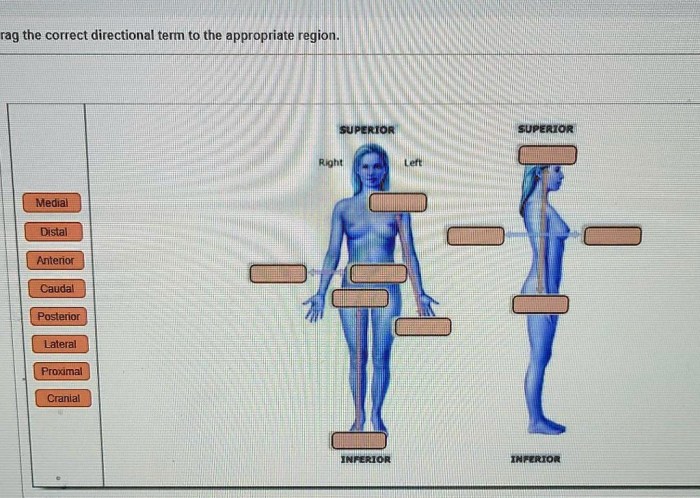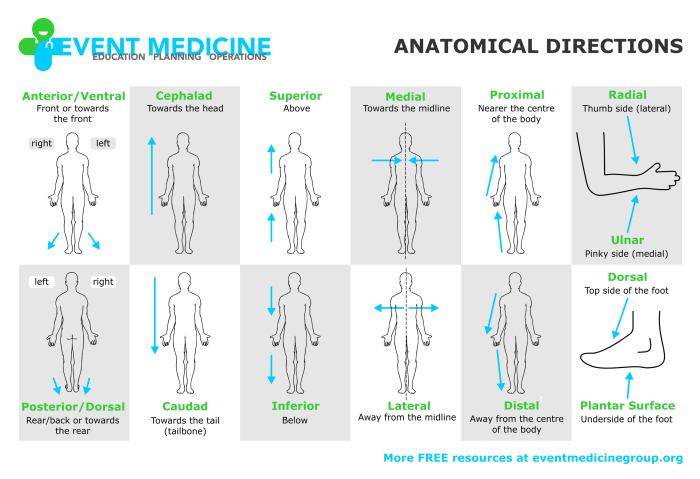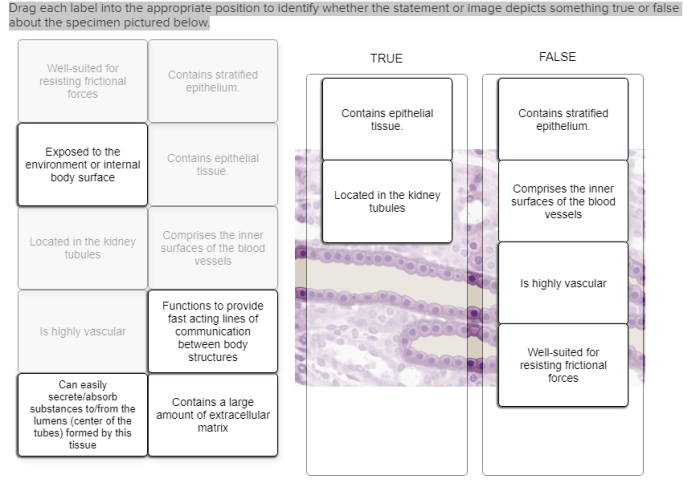Embarking on a journey of anatomical exploration, we present “Drag the Correct Directional Term to the Appropriate Region,” an interactive learning experience that empowers individuals to grasp the intricacies of directional terminology and their application to the human body. This engaging activity fosters a deeper understanding of anatomical landmarks, facilitating effective communication among healthcare professionals and enhancing patient care.
Delving into the realm of directional terms, we uncover their precise definitions, explore their practical applications, and delve into the diverse regions of the human body. Through a series of interactive exercises, learners will refine their ability to identify and locate anatomical structures with accuracy and confidence.
Directional Terms

Directional terms are used to describe the location of one structure relative to another. They are commonly used in anatomy, physiology, and other medical fields.
The following table provides a list of common directional terms, along with their definitions, examples, and illustrations:
| Directional Term | Definition | Example | Image/Illustration |
|---|---|---|---|
| Anterior | Front or ventral surface | The anterior surface of the body is the chest. | [Image of the anterior surface of the body] |
| Posterior | Back or dorsal surface | The posterior surface of the body is the back. | [Image of the posterior surface of the body] |
| Superior | Above or higher | The brain is superior to the spinal cord. | [Image of the brain and spinal cord] |
| Inferior | Below or lower | The stomach is inferior to the heart. | [Image of the stomach and heart] |
| Medial | Toward the midline of the body | The nose is medial to the eyes. | [Image of the nose and eyes] |
| Lateral | Away from the midline of the body | The ears are lateral to the eyes. | [Image of the ears and eyes] |
Regions of the Body

The human body can be divided into several regions, each with its own unique set of directional terms.
- Head: The head is the uppermost region of the body and includes the brain, eyes, ears, nose, and mouth.
- Neck: The neck is the region that connects the head to the body and includes the trachea, esophagus, and vocal cords.
- Thorax: The thorax is the region that contains the heart, lungs, and other organs of the chest.
- Abdomen: The abdomen is the region that contains the stomach, intestines, and other organs of the digestive system.
- Pelvis: The pelvis is the region that contains the bladder, rectum, and other organs of the reproductive system.
Drag-and-Drop Activity

The following drag-and-drop activity allows users to practice matching directional terms to regions of the body.
- Instructions: Drag and drop the directional terms to the correct regions of the body.
- Directional terms: Anterior, Posterior, Superior, Inferior, Medial, Lateral
- Regions of the body: Head, Neck, Thorax, Abdomen, Pelvis
Assessment: Drag The Correct Directional Term To The Appropriate Region
The following method can be used to assess students’ understanding of directional terms and regions of the body:
- Multiple-choice questions: Students can be given a series of multiple-choice questions that test their knowledge of directional terms and regions of the body.
- Short answer questions: Students can be asked to answer short answer questions that require them to use directional terms to describe the location of different structures in the body.
- Lab practical: Students can be asked to perform a lab practical that requires them to identify different regions of the body and use directional terms to describe their location.
Common Queries
What are the benefits of using “Drag the Correct Directional Term to the Appropriate Region”?
This activity enhances understanding of directional terminology, promotes accurate identification of anatomical structures, and fosters effective communication among healthcare professionals.
How can I access “Drag the Correct Directional Term to the Appropriate Region”?
The activity is typically incorporated into educational materials or online platforms designed for anatomy and physiology instruction.
What is the target audience for “Drag the Correct Directional Term to the Appropriate Region”?
This activity is suitable for students, healthcare professionals, and anyone seeking to enhance their knowledge of anatomical terminology.